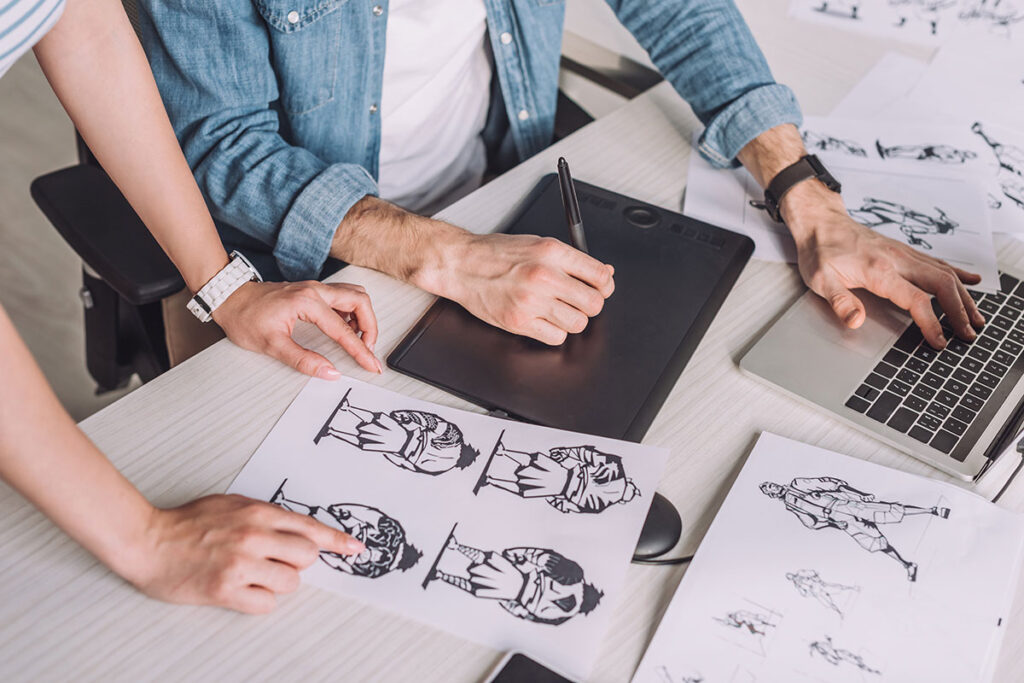Empowering Creativity: How Designers Can Overcome Challenges and Thrive

Table of Contents
Empowering Creativity: How Designers Can Overcome Challenges and Thrive
Creativity plays a crucial role in producing compelling designs that captivate audiences. However, creative professionals often face challenges like tight deadlines, unhealthy work environments, and limited freedom, all of which can negatively impact their work. This article explores how creative designers can overcome these challenges and thrive in their roles. We’ll cover essential factors such as competitor research, brainstorming, and creative copywriting. Finally, we’ll dive into tips for building a healthy work environment that supports creative success.

Challenges Creative Designers Face with Deadlines
(Empowering Creativity: How Designers Can Overcome Challenges and Thrive)
Creative designers often struggle with tight deadlines due to the unpredictable nature of the creative process. Creativity isn’t something that can be forced or rushed—ideas sometimes take time to develop, and rushing can hinder the quality of the final product. When deadlines are too tight, designers may feel overwhelmed, which can lead to frustration, burnout, and less innovative designs. Balancing creativity with time constraints requires strong time management, but even the best plans can be disrupted by creative blocks or sudden client revisions.


Impact of an Unhealthy Work Environment on Creativity
(Empowering Creativity: How Designers Can Overcome Challenges and Thrive)
When creative professionals are subjected to unhealthy work environments—whether it’s due to stress, lack of resources, or poor communication—creativity tends to suffer. Stress and negativity can stifle imagination, making it harder for designers to focus and innovate. In such environments, designers may feel disconnected from their projects, leading to lower-quality work and missed opportunities for creative innovation. A positive, healthy work environment is key to nurturing creativity, allowing designers to feel inspired and motivated to produce their best work.


Essential Elements of a Healthy Creative Work Environment
(Empowering Creativity: How Designers Can Overcome Challenges and Thrive)
A healthy work environment for creative designers should include several key factors:
- Mental and Emotional Support: Providing encouragement and constructive feedback in a supportive way.
- Physical Comfort: Adequate lighting, comfortable seating, and ergonomic setups that allow designers to work without distraction.
- Freedom to Explore Ideas: Designers need the flexibility to experiment with ideas without immediate judgment or strict guidelines.
- Work-Life Balance: Allowing breaks and time away from work is essential to maintain long-term creativity and prevent burnout.
- Collaboration and Communication: A culture of open communication ensures that ideas can be shared and refined with ease.


Freedom Required by Creative People to Produce Winning Designs
(Empowering Creativity: How Designers Can Overcome Challenges and Thrive)
Creative professionals thrive when they are given the freedom to explore, experiment, and take risks. Micromanaging creative work can hinder innovation and stifle new ideas. Designers need autonomy to test out different concepts and techniques. Allowing flexibility in the creative process gives them the room to generate fresh, original ideas that can result in standout designs. Encouraging this freedom is key to producing work that truly resonates with audiences.

Timeframes for Producing Creative Designs
(Empowering Creativity: How Designers Can Overcome Challenges and Thrive)
There isn’t a one-size-fits-all timeframe for creative work because the process can vary greatly depending on the project, individual, and complexity of the design. However, team leaders can establish general timeframes by:
- Breaking Projects into Stages: Define stages like brainstorming, concept development, revision, and finalization, and allocate time for each stage.
- Setting Milestones: Establish checkpoints where progress can be reviewed without overwhelming pressure.
- Allowing for Revision Time: Ensure there’s enough time for feedback and revisions, as creativity often requires refining ideas.
While deadlines are important, they should not turn into a race. It’s essential to leave some room for spontaneous creativity and revisions.

The Role of Competitor Research and Brainstorming
(Empowering Creativity: How Designers Can Overcome Challenges and Thrive)
Competitor research is essential for producing competitive and appealing creative designs. By examining what competitors are doing, creative teams can identify trends, avoid redundant ideas, and find ways to differentiate their designs. Additionally, brainstorming sessions are powerful tools for idea generation. These sessions encourage collaboration and help spark innovative solutions by bringing diverse perspectives to the table. When done right, brainstorming helps produce designs that not only stand out but also align with the goals of the product or service being promoted.

The Role of Creative Copywriting in Design
(Empowering Creativity: How Designers Can Overcome Challenges and Thrive)
Creative copywriting plays a vital role in supporting and enhancing visual design. Strong copy provides context, clarity, and emotional appeal, strengthening the overall impact of the design. Collaborating closely with copywriters ensures that the visual elements of a design are perfectly aligned with the message being communicated. Whether it’s a tagline, slogan, or descriptive text, the right words add value to a design, making it more persuasive and memorable.

Additional Points to Consider
(Empowering Creativity: How Designers Can Overcome Challenges and Thrive)
1. The Importance of Creative Rest and Inspiration
Creative rest is essential for maintaining productivity. Constantly pushing designers without giving them time to rest can lead to creative burnout. Allowing regular breaks, whether it’s stepping away from the screen for a few minutes or taking a day off, helps recharge their creativity. Exposure to new experiences, such as visiting art galleries, reading, or simply taking a walk, fuels new ideas and fresh perspectives that can be brought back to the design process.

2. Technology and Tools for Designers
Designers need access to modern tools and software to keep up with industry trends and improve efficiency. Outdated or slow tools can cause frustration and slow progress. Providing the right technology—such as advanced graphic design software, collaboration platforms, and digital drawing tablets—allows designers to work more effectively. Offering ongoing training in new tools and techniques ensures they remain competitive and capable of delivering innovative solutions.


3. Encouraging Feedback Loops
Feedback is crucial to refining creative work, but it needs to be constructive and timely. Regular feedback loops—where team members, clients, or stakeholders review work at various stages—help ensure that the project remains aligned with its objectives. These loops prevent last-minute revisions, reduce stress, and improve the final product. Positive feedback also boosts morale and encourages designers to push their creative boundaries.

4. Adapting to Client Preferences While Maintaining Creative Integrity
Balancing client expectations with creative integrity is one of the toughest challenges designers face. Clients may have a vision in mind, but it’s not always aligned with what the designer feels is the best approach. To manage this, designers need to maintain clear communication, asking the right questions to understand the client’s goals while explaining their own creative choices. Finding a compromise where both parties are satisfied ensures that the final product meets the client’s expectations without sacrificing the designer’s creativity.

5. The Role of Team Dynamics in Creative Projects
Team dynamics play a significant role in the success of creative projects. In a team setting, designers collaborate with writers, developers, and project managers. A positive and collaborative atmosphere leads to better results. Team leaders should foster an environment where everyone’s contributions are valued and ideas are shared openly. Respecting different perspectives ensures that the final design is more innovative and well-rounded.

6. Budget Constraints and Creativity
Budget constraints can limit the creative process, but they can also push designers to think more creatively. Working within a limited budget forces designers to be resourceful, finding new ways to achieve desired results without overspending. This can lead to unexpected, imaginative outcomes. Team leaders should communicate budgetary restrictions early on so that designers can adjust their creative approach accordingly.

In this article, we covered the following topics:
- “Empowering Creativity: How Designers Overcome Challenges with Deadlines, Environment, and More”
- “Unlocking Creativity: Key Strategies for Designers to Thrive in Challenging Work Environments”
- “Boosting Designer Performance: How Freedom, Time Management, and Environment Play a Role”
- “Creative Success: Secrets to Helping Designers Overcome Challenges and Thrive”
- “Nurturing Creativity: How to Support Designers Facing Tight Deadlines and Tough Clients”
Conclusion: Nurturing Creativity for Success
(Empowering Creativity: How Designers Can Overcome Challenges and Thrive)
A thriving creative team is one that feels supported, inspired, and free to explore new ideas. Whether it’s providing a healthy work environment, access to the latest tools, or enough time for inspiration and rest, leaders play a key role in nurturing creativity. Balancing client expectations, managing deadlines, and giving creative freedom are all vital to producing outstanding work. Creativity is a delicate process that requires patience and understanding, but when handled correctly, it leads to powerful, innovative designs that elevate brands, products, and services.
By implementing these practices, creative departments can ensure their designers are set up for success, even in the face of challenges like deadlines, budget constraints, or client demands.
Please read more insights on “Creativity: Challenges to a key concept for the XXI century”
Please check for articles on other categories
Appeal to www.USAinfy.com Readers
Thank you for visiting www.USAinfy.com! We greatly value your presence here and your interest in our articles. Your thoughts and feedback are incredibly important to us, and we’d love to hear from you. Please take a moment to leave a comment on our articles and share your insights. Your feedback helps us improve and deliver more content that matters to you.
If you enjoyed the article or found it helpful, don’t forget to share it with your friends and family. Together, we can continue building a community that stays informed and engaged. Let us know what you think, and feel free to share your suggestions for future topics!